Marilyn91
Well-Known Member
Hi everyone,
My Connemara pony seems a bit off. Some mornings she is very stiff, limping out of her stable, then after a few minutes on the lunge she loosens up and moves normally. While a few minutes of exercise seem to help initially, overall she is worse if she has been ridden the previous day, especially on the road. She used to be extremely forward-going (too much so!) but on the lunge she doesn't track up anymore, and under saddle she is very reluctant to move forward. Out hacking, she will move forward, but my friend who was out with me said she was moving strangely, and that it looked like she was putting too much pressure on her back legs. She also stumbles quite a lot, even when walking in hand, and she really struggles with hills.
I had the chiropractor come and take a look a few days ago, and the pony's front left leg made a cracking sound when she stretched it. She recommended me to get a farrier to do a hoof test.
I'm wondering whether I should get the vet out, or the farrier, or both and which one should come out first? Would it be worth giving her a month off?
I've uploaded a few pictures of her hooves, just in case I'm missing something obvious.
I would appreciate any insight as she is my first horse and I'm feeling a bit overwhelmed ?
My Connemara pony seems a bit off. Some mornings she is very stiff, limping out of her stable, then after a few minutes on the lunge she loosens up and moves normally. While a few minutes of exercise seem to help initially, overall she is worse if she has been ridden the previous day, especially on the road. She used to be extremely forward-going (too much so!) but on the lunge she doesn't track up anymore, and under saddle she is very reluctant to move forward. Out hacking, she will move forward, but my friend who was out with me said she was moving strangely, and that it looked like she was putting too much pressure on her back legs. She also stumbles quite a lot, even when walking in hand, and she really struggles with hills.
I had the chiropractor come and take a look a few days ago, and the pony's front left leg made a cracking sound when she stretched it. She recommended me to get a farrier to do a hoof test.
I'm wondering whether I should get the vet out, or the farrier, or both and which one should come out first? Would it be worth giving her a month off?
I've uploaded a few pictures of her hooves, just in case I'm missing something obvious.
I would appreciate any insight as she is my first horse and I'm feeling a bit overwhelmed ?
Attachments
-
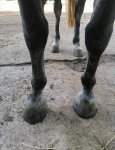 Screenshot_20220703_201004.jpg754.7 KB · Views: 90
Screenshot_20220703_201004.jpg754.7 KB · Views: 90 -
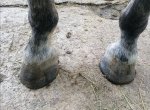 Screenshot_20220703_200952.jpg511.5 KB · Views: 89
Screenshot_20220703_200952.jpg511.5 KB · Views: 89 -
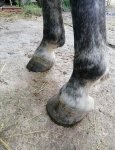 Screenshot_20220703_200936.jpg794.2 KB · Views: 90
Screenshot_20220703_200936.jpg794.2 KB · Views: 90 -
 Screenshot_20220703_200917.jpg585.1 KB · Views: 91
Screenshot_20220703_200917.jpg585.1 KB · Views: 91 -
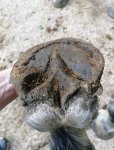 Screenshot_20220703_200857.jpg608.2 KB · Views: 89
Screenshot_20220703_200857.jpg608.2 KB · Views: 89 -
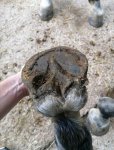 Screenshot_20220703_200812.jpg541.9 KB · Views: 82
Screenshot_20220703_200812.jpg541.9 KB · Views: 82
